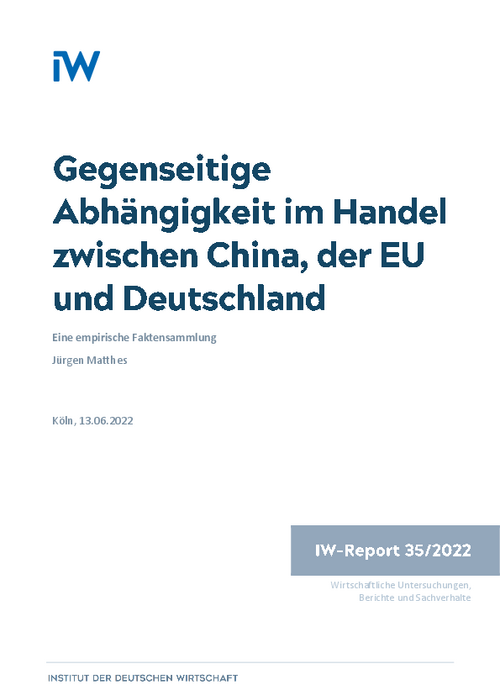An inventory of the mutual dependencies in foreign trade between the EU and Germany on the one hand and China and Russia on the other is necessary in order to be able to make political deductions in these times of “Zeitenwende” on a sound empirical basis.

Mutual dependence in trade between China, the EU and Germany

An inventory of the mutual dependencies in foreign trade between the EU and Germany on the one hand and China and Russia on the other is necessary in order to be able to make political deductions in these times of “Zeitenwende” on a sound empirical basis.
The interdependencies determined on the basis of value-added trade data from the TIVA database of the OECD (as of 2018) are generally greater than if merchandise trade in goods alone is considered as usual. In terms of value-added import and export shares in relation to foreign trade with all countries, China is still moderately more dependent on the EU than the EU is on China. However, when value-added imports and exports are put in relation to the total value added of the whole economy, the shares not only fall very significantly because domestic value added is added to the denominator, but China's dependence also decreases (in relative terms): On the EU import side, 2 percent of total value added in EU final demand comes from China, and on the EU export side, 2 percent of total EU value added goes into Chinese final demand. The shares for China on both the import and export sides are 2.2 percent, so China's dependence on this crucial measure is only slightly higher.
On the export side, value-added-related job dependence can also be calculated. Measured in terms of total employment, the shares on both sides are similar to the value-added shares of the total economy. But in absolute terms, they differ significantly in 2018: In China, 15.7 million jobs depend directly or indirectly on EU final demand and 4.1 million on Germany's final demand, while there are about 3.5 million jobs in the EU and about 1.1 million jobs in Germany that depend on China's final demand. On the export side, Germany is much more dependent on China than the other way around: 2.7 percent of Germany's total economic value added and 2.4 percent of total employment depend on exports into China’s final demand. By contrast, the figures for China are only 0.5 and 0.6 percent.
In summary, regarding the relevance of bilateral trade for the economy as a whole, China is only slightly more dependent on the EU than the EU is on China. Germany, on the other hand, is much more depen-dent on China, especially on the export side, but also on the import side, than vice versa. All in all, the overall economic trade dependencies are not outsized, amounting to only 2 to 3 percent of total econo-mic output in the EU and China, respectively.

Mutual dependence in trade between China, the EU and Germany

More on the topic
Not so Different?: Dependency of the German and Italian Industry on China Intermediate Inputs
On average the German and Italian industry display a very similar intermediate input dependence on China, whether accounting for domestic inputs or not.
IW
China’s Trade Surplus – Implications for the World and for Europe
China’s merchandise trade surplus has reached an all-time high and is likely to rise further. A key driver appears to be a policy push to further bolster Chinese domestic manufacturing production, implying the danger of significant overcapacities.
IW